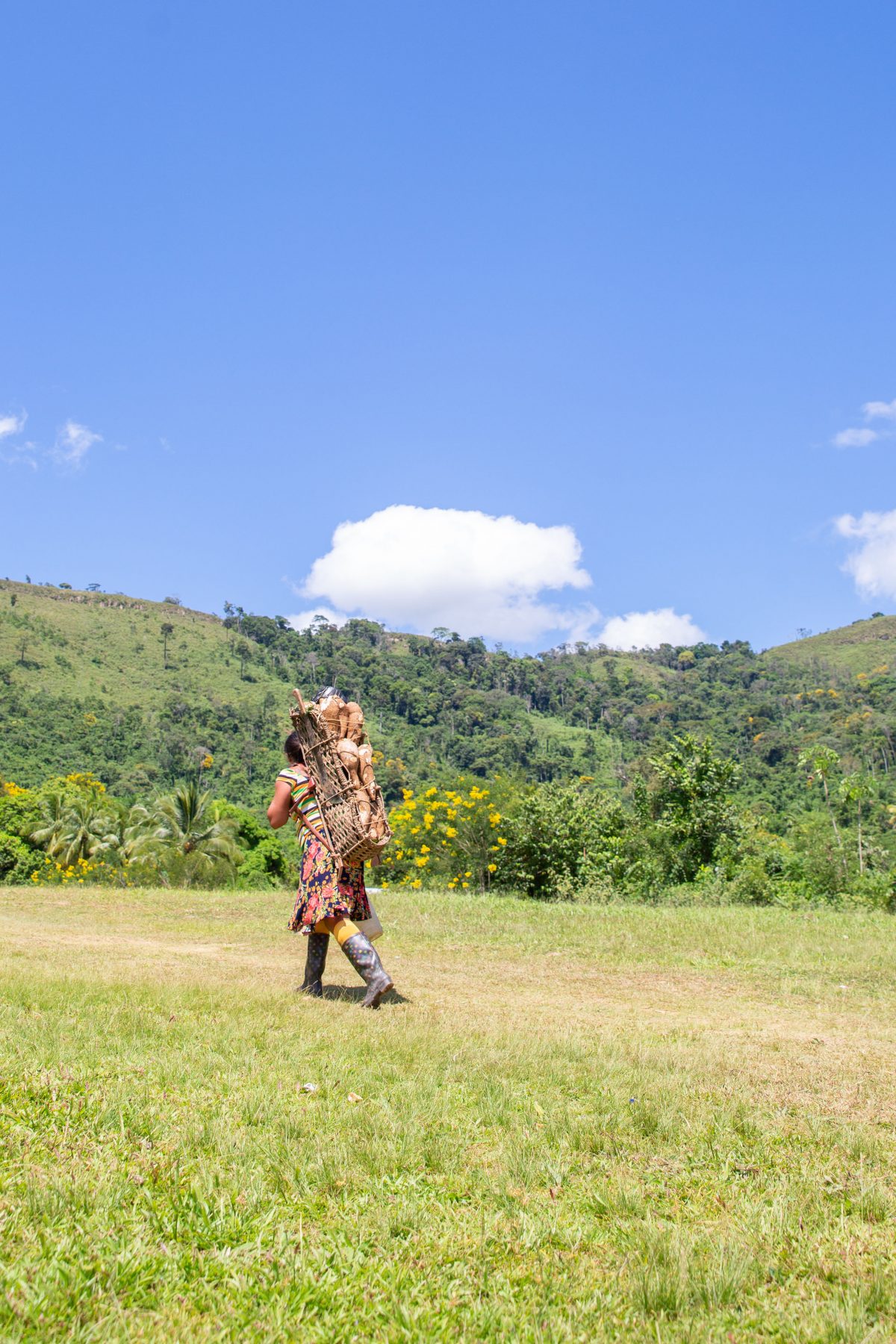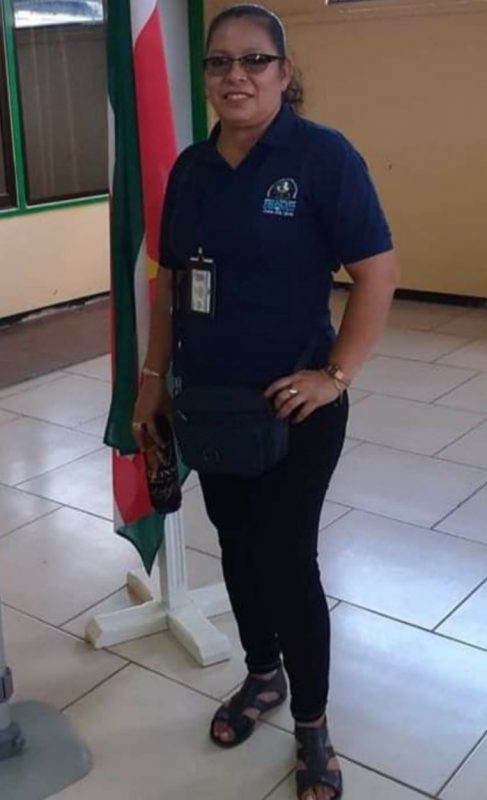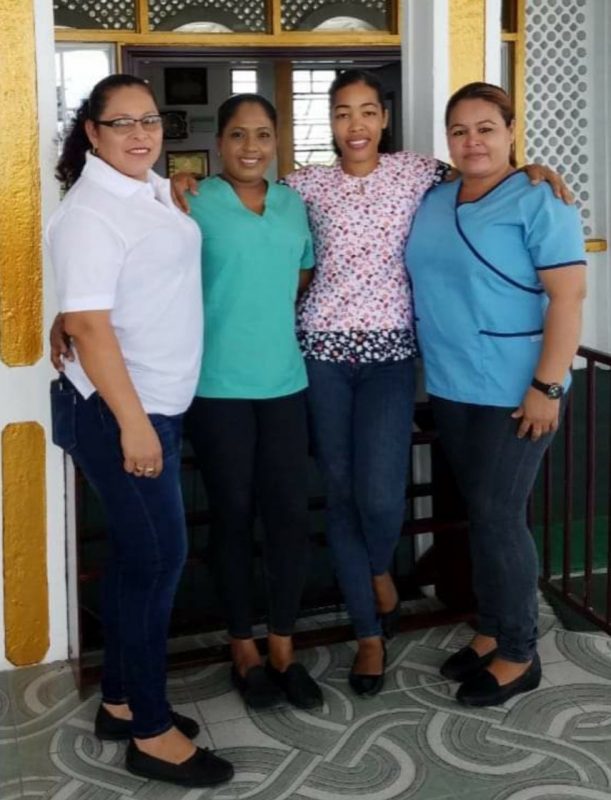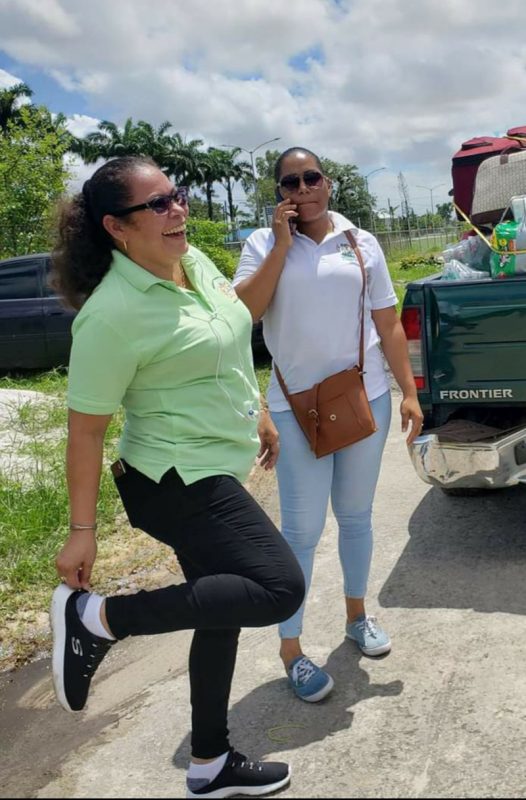Near the end of April last year, shortly after she tested positive for COVID-19, Lolita Rebeiro was diagnosed with cancer.
Rebeiro, 45, Chief Medex, Regional Health Services, Ministry of Health, was treated locally and completed treatment in Suriname at the start of last December. “I haven’t been cleared as yet by the doctors. However, it’s back to work for me,” Rebeiro told Stabroek Weekend in an interview.
Rebeiro, who has spent six years as Chief Medex, had initially dreamed of becoming a nurse and working at the Kumaka District Hospital in her home village of Santa Rosa in the Moruca Sub-Region. It was a dream she realised and then some.
The seventh of 13 children – she has seven brothers and six sisters — Rebeiro noted that her mother, the late Teacher Rita Rebeiro, tried to dissuade her from pursuing her dreams because of the fear that she could have come into contact with persons living with HIV/AIDS and become infected. At the time, HIV/AIDS had been making the headlines.
“Mom was trying to daunt my spirits but I held out. She had wanted me to become a teacher. Once she knew I had made up my mind, she gave up and told me to follow my heart’s desire,” Rebeiro said.
As soon as she left Santa Rosa Secondary School, where she was among the first batch of 15 students to graduate in 1995, she enrolled in the professional nursing programme at the Georgetown School of Nursing to pursue her career.
Her educational path to Georgetown School of Nursing was not an easy one, she said. She recalled writing the common entrance examinations for entry to secondary school and being awarded a place at North West Secondary School in Mabaruma. Due to the distance and lack of reliable means of transportation and communication and having no relatives at Mabaruma, she obtained a transfer to Abram Zuil Secondary on the Essequibo Coast.
As an 11-year-old, she found it difficult to adjust to her guardian’s lifestyle and demands and became homesick. At that early age, she felt she was also disrespected because of her ethnicity. At the time her mother was also a student at the Cyril Potter College of Education and could not be in contact with her as readily as she would have liked.
After one year, Rebeiro did not return to Abram Zuil and was accepted in the secondary department of Santa Rosa Primary School. When she was in form three, plans were being put in place to open the Santa Rosa Secondary School. Eligible students were being taught in two classes even before the school was gazetted. Both Rebeiro and her brother after her, started attending classes at the school at the same time.
“Teacher Vic (the late Victor Ferreira) identified students who he believed would perform well.
He used to tell us ‘You can do it.’ Eventually he placed the top performers from the two classes in one, which he called Form Three Special. The other class in which my brother was in, was called Form Three. When it was time to write exams it was a challenge for my mother to pay for both of us. She paid for me to write several subjects but my brother stayed back and wrote the following year. We wrote CSEC (Caribbean Secondary Education Certificate) exams in 1995. I was in the first batch that wrote and the first batch that graduated. We were eight boys and seven girls. Among my batch was Colin De La Cruz, who is now the headmaster of Waramuri Primary, and Graham Atkinson, who is a radio broadcaster and community activist, among other things. Others from my batch are teachers who are either senior masters or mistresses or deputy heads. I’m very proud of the first batch. You can say we have led the way.”
Rebeiro started the professional nursing programme in September 1995, immediately after obtaining her CSEC results. “I had many challenges, financial and what’s not. To be honest, some mornings I went to school without breakfast. It was my brother Lovell, who was at the University of Guyana, and I—both of us were teenagers trying to make it on our own in town. At that time, we rented a small apartment in Cummings Lodge. We slept on one bed. Imagine two young adults, brother and sister, sleeping on one bed, head and tail, but we were committed and we made it.”
Becoming a medex
On the completion of training in 1999, Rebeiro was assigned to the Georgetown Public Hospital Corporation (GPHC). In 2003, at her request, she was transferred to the Kumaka District Hospital (KDH) in Santa Rosa, Moruca. At KDH, she saw the need for another Medical Extension Officer (Medex). “I wanted to do more for our people. There was one medex serving a large population. There was no doctor.” She worked for a year and nine months and successfully applied to do the Medex training programme, which began in September 2004.
At that time, registered nurses meeting certain criteria, including at least completing a year of service in the hinterland, were recruited for the medex programme. “With my three years at GPHC and the time I spent at KDH, I was eligible to apply.”
Medexes are normally called “barefoot doctors” and perform certain clinical functions in the absence of medical doctors. “When we graduated in 2006, there was no doctor in Region One and only two medexes. One was in Mabaruma and one was in Moruca. Four newly-trained medexes, Medex Barnes, Medex Edghill, Medex Gilkes and myself, were sent to the region to join a team of two.”
When Rebeiro returned to work at KDH in September 2006 as a medex, she was eager to work along with the late Medex Lexus Jose to improve the health situation in the sub-region. “We worked together to improve a number of areas, especially the vaccination programme. Four and a half months after working with him, he took his own life in the living quarters in the hospital compound. At the time he was in the process of being transferred to Matthews Ridge.
“His death by suicide was very heartrending. I was still new on the job. I was left alone. I worked from January 2007 to 2009 by myself on duty, ’round-the-clock without any on-call allowance and without any overtime. Just a flat salary. When patients came at nights, I had to get up. I had a midwife and a nursing assistant for a very large population. I was responsible for KDH and at the same time supervising 18 other health facilities, including two health centres and 16 health posts.”
In early 2009, a diarrheoa outbreak in the Moruca sub-region claimed the lives of five people. The ministry sent a Cuban doctor to assist in the caseload at KDH. “While the doctor was stationed at KDH, I went to Barama where there were several cases. Patients came to meet us in the river or wherever we were. Because of the urgency and the state of the patients, there were times when sometimes we set up a saline for the patient in the boat while travelling and taking them back to a health post. Because of the lack of beds, we either had to put them in hammocks or on a foam mattress on the desks in the nearby school. Those were very challenging times.”
She subsequently worked with several Cuban doctors before Guyanese doctors were assigned at KDH.
The first Guyanese doctor she worked with at KDH was Dr Hans Madeleke, from whom she learned a lot, she said. “Working on my own I gained a lot of experience. Certain things, pertaining to psychiatry, orthopedics, or gynaecology, I called the specialist doctors who were always ready to advise and guide.”
She spent a total of seven years as a medex at KDH and three years at Port Kaituma District Hospital (PKDH). “I was so longing to serve my community for as long as I could. It wasn’t my desire to be transferred to PKDH and I requested to stay at KDH. However, the Regional Health Officer said the department was rotating staff and I had to leave. I left in tears that morning in the boat heading to PKDH.”
The workload was easier at PKDH as she was no longer in charge of the management of the hospital. She took charge of the Maternal and Child Health Department. Only in the absence of the doctor at PKDH would she take charge and tend to outpatients and ward patients. The health facilities that PKDH had oversight over numbered 4 compared to 18 at KDH. There were also more nurses and doctors on the staff at Port Kaituma.
After three years at PKDH, Rebeiro was ready to take on another challenge. In late 2015, the Ministry of Health needed to fill the post of Chief Medex. At the time, she said, she was experiencing some personal problems and she needed a change in environment. “I didn’t want to resign because helping people was what I was trained to do.”
She applied for the post of Chief Medex, and was subsequently called for an interview in early December. “From Kaituma I travelled for the interview and returned the next day to go straight into the fields.”
A week after the interview she was informed she was selected for the post and was asked to report for duty in January 2016.
“In Georgetown it was a challenge for me. I was used to clinical work and not to the administrative side of things. When I took over there was no Chief Medex to hand over. Prior to my appointment, the ministry had been without a Chief Medex for three years. I studied my job description and worked with that, doing research and going into files and cabinets to obtain information. There was no database on the medexes who were across the country.
She continued, “Just getting information about the medexes and the community health workers in the regions was a challenge. Creating a database for them took me about a year as information from far flung areas trickled in. They had been operating under the supervision of the regional health officers.”
Her work involves supervisory visits to different regions to ensure, among other things, that records and reports are up to date but visits have been curtailed due to the COVID-19 pandemic.
COVID-19 in the hinterland
With the onset of the pandemic and the increase in cases in the hinterland areas, her focus became curbing the spread of the virus.
“When Santa Rosa Village became the epicenter of the pandemic in the country, I had to do something. I was born and raised there and I wanted to help. I saw the need for us to go because of the rapid increase in cases. The two residential doctors, the medex, two nurses and cooks all tested positive. That was when I contacted two doctors who were born in the village, Dr Arielle Savory and Dr Sarah Benjamin. They were both willing to go. It was a challenge getting doctors to go to Moruca. Doctors who were willing to work with COVID-19 patients were already occupied on the coastland and some others were reluctant to go.”
At Kumaka District Hospital, the doctors did the clinical work and Rebeiro took on the administrative role. At the peak they treated over 90 cases.
“At one time there wasn’t enough accommodation for patients. We had to use three different sites. For us it was learning and doing our best by trial and error. The doctors visited the centres two times a day. Night time was evaluation and meetings with the task force. This is where I had to liaise with the community via the Santa Rosa Village Council, which brought on board members of the community to come out and assist in cooking. We were there for six weeks. Before we left the cases were brought under control. Thank heavens our medical team did not contract the virus.”












